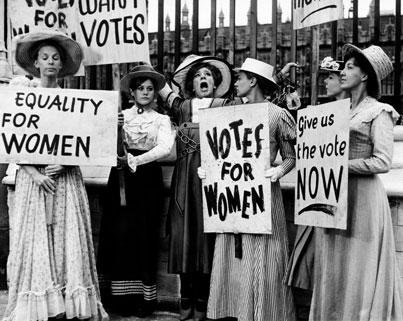
Women protested for the right to vote. Photo by Transgender Bisexual Political Nerd
100th Anniversary of the 19th Amendment
“The right of citizens of the United States to vote shall not be denied or abridged by the United States or by any State on account of sex.”
These words were officially adopted into the United States Constitution in 1920 as part of the 19th Amendment, granting women the right to vote throughout the country. This was the product of over 70 years of hard work by suffragettes, women who protested for the right to vote. Thanks to this, women gained more political power and could influence policy decisions. This gradually led to greater protections for women, such as reproductive rights and fair economic treatment, as they became an important voting bloc and made their voices heard. Thus, the 19th Amendment played an essential role in ensuring equality for women.
The national movement pushing for this right began in 1848 through the Seneca Falls Convention in New York. 300 people attended, including prominent feminist and civil rights leaders Elizabeth Cady Stanton, Lucretia Mott, and Frederick Douglass. There, they created the Declaration of Sentiments based off of the Declaration of Independence that detailed 19 “abuses and usurpations” women were forced to endure and called for equality for women in all aspects of life, including the right to vote. Despite ridicule from the press, activists continued to hold other conferences and gained support from more feminists, including Susan B. Anthony.
The movement was weakened during the Civil War as women focused on aiding their states. Once the war ended, they were divided over the 15th Amendment, which would grant African-American men the right to vote, as it did not include women as well. This split the movement into two groups: the National Woman Suffrage Association (NWSA) led by Anthony and Stanton and the American Woman Suffrage Association (AWSA). The NWSA pushed for a new amendment to the Constitution to grant women the right to vote, while the AWSA focused on passing legislation for women’s suffrage on the state level. Through their efforts, Wyoming became the first U.S. territory to allow women to vote in 1869.
In 1890, the two organizations merged to form the National American Woman Suffrage Association and began to lobby for women’s suffrage within each state, passing legislation in Colorado, Utah, and Idaho within six years. Under the leadership of Carrie Chapman Catt, voting rights were given to women in several states, including California, Nevada, New York, and Washington, from 1910 to 1918.
By 1913, during the presidency of Woodrow WIlson, the Congressional Union for Woman Suffrage was founded by Alice Paul, which used militant tactics and caused many protestors to be arrested. Soon, WIlson agreed to support the movement, but a new amendment failed in the Senate in 1918. In 1919, Congressman James R. Mann proposed a new amendment for women’s suffrage that passed both the House of Representatives and the Senate. Despite opponents in the South, it was ratified by the states and was added to the Constitution on Aug. 19, 1920.